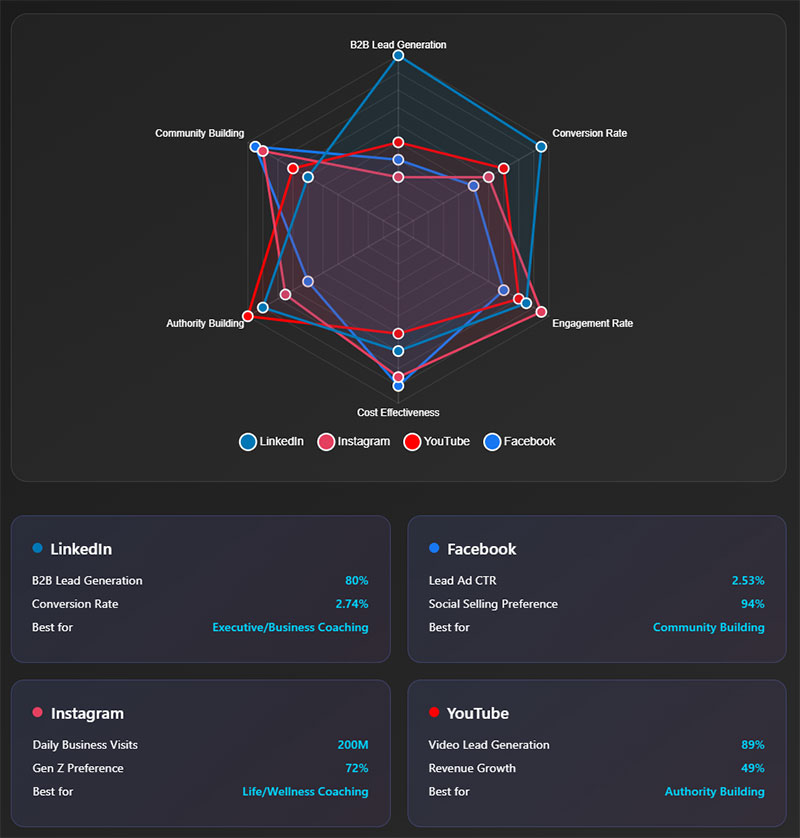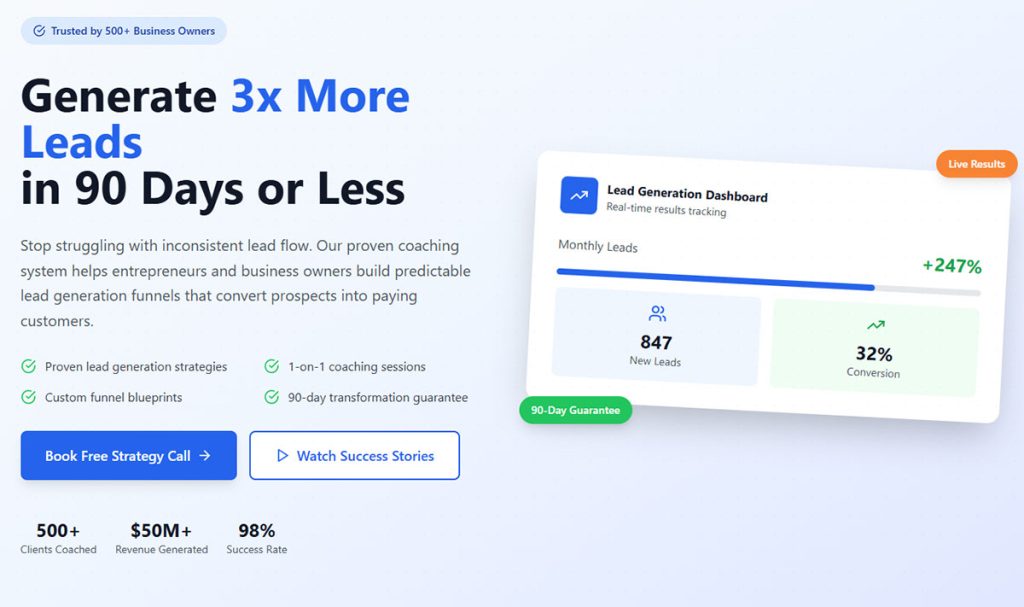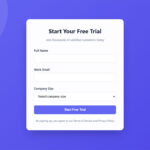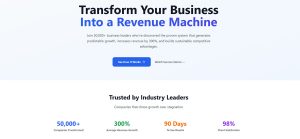Your technical expertise means nothing if nobody knows you exist. Lead generation for accountants has shifted dramatically. Referrals alone no longer fill client pipelines the way they did ten years…
Table of Contents
Most coaches struggle to fill their client roster despite having transformational skills. You might excel at helping people achieve breakthrough results, but attracting those people in the first place? That’s a different challenge entirely.
Lead generation for coaches requires specific strategies that go beyond traditional marketing approaches. Life coaches, business coaches, and wellness coaches all need consistent prospect pipelines to build sustainable practices.
The coaching industry has exploded, creating more competition than ever. Your expertise in mindset coaching, executive coaching, or relationship coaching means nothing if potential clients can’t find you.
This guide reveals proven client acquisition strategies that successful coaches use to generate qualified leads consistently. You’ll discover content marketing tactics, social media approaches, and conversion techniques that turn prospects into paying clients.
By implementing these lead generation strategies, you’ll build a reliable system for attracting your ideal coaching clients rather than hoping they stumble across your services.
Content Marketing Strategies That Convert
Content marketing drives successful client acquisition for coaching professionals. The global coaching industry reached $7.31 billion in 2025, with smart coaches understanding that valuable content builds trust before prospects ever book consultation calls.
Creating High-Value Lead Magnets
Lead magnets serve as your first impression with potential coaching clients. Research shows 50% of marketers using lead magnets have higher conversion rates than those who don’t. These resources should solve specific problems your ideal clients face daily.
Educational guides work exceptionally well for life coaches and business coaches. A career coaching specialist might create a “30-Day Job Search Action Plan” that addresses common concerns about professional transitions.
Assessment tools generate massive engagement. Webinar conversion rates can surpass 50%, making them powerful lead generation tools. Mindset coaching practitioners often develop personality assessments or goal-setting worksheets that provide immediate value while capturing contact information.
Templates and worksheets appeal to action-oriented prospects. Executive coaching professionals can offer meeting agenda templates or leadership development frameworks that busy professionals actually use.
Exclusive webinars and masterclasses position you as authority figures. Webinars have conversion rates ranging from 25-56% for attendees turning into leads. Performance coaching experts frequently host live sessions on breakthrough techniques or transformation strategies.
Key Lead Magnet Performance Statistics:
- Video content preferred by 72% of consumers for learning about services
- Mini-courses convert higher than static PDFs
- Checklists and templates have broad appeal across coaching niches
- Assessment tools create personalized experiences that increase engagement
Blog Content for Lead Generation
Problem-focused articles attract prospects actively searching for solutions. Write about specific challenges your target audience faces rather than generic advice.
Case studies demonstrate real results from your coaching methodology. Share client success stories (with permission) that highlight measurable outcomes and specific behavior changes. 73% of coaching clients say coaching improves relationships and communication skills.
How-to guides establish your expertise while providing actionable value. Wellness coaches might publish step-by-step articles on creating morning routines or developing accountability systems.
Industry insights show you understand current trends. Relationship coaching professionals can write about communication patterns or attachment styles based on recent research.
Blog Content Success Metrics:
- Blog posts with video content attract 3x more backlinks
- 32% of B2B content marketers reported success with 2024 strategies
- 94% of B2B marketers create short articles and blog posts
- Organic search accounts for 52.7% of B2B revenue share
Video Content Production
Educational video series build deeper connections than written content alone. Record short tutorials that address frequently asked questions from your consultation discovery calls.
Video content drives remarkable results: Including videos on landing pages can boost conversions by 80%. Sites using video have 4.8% conversion rates compared to 2.9% for those without video.
Client testimonials provide social proof that written reviews cannot match. Video testimonials feel more authentic and help prospects visualize their own transformation journey.
Behind-the-scenes content humanizes your coaching practice. Show your actual workspace, daily routines, or preparation methods for client sessions.
Live streaming creates real-time engagement opportunities. Host Q&A sessions where you answer questions about goal achievement or skill development challenges.
Video Marketing Impact for Coaches:
- 90% of marketers report video boosting ROI
- 87% of marketers say video generates more leads
- Companies using video marketing grow revenue 49% faster
- 84% of consumers buy products after watching marketing videos
- Users stay 3x longer on pages with video content
Strategic Content Distribution
Content creation represents only half the equation. The coaching industry now has 167,760 active coaches in 2025, up from 71,000 in 2019. Standing out requires strategic distribution.
Email marketing remains highly effective. Email marketing delivers $42 ROI for every $1 spent. Video emails increase click-through rates by 200-300%.
Social media amplification extends content reach. LinkedIn video posts get shared 20x more than other content types. Focus on platforms where your ideal clients spend time.
SEO optimization ensures content discovery. 75% of marketers believe AI-enabled search engines will positively impact their blogs.
Distribution Best Practices:
- 63% of web traffic comes from mobile devices (optimize accordingly)
- Short-form video is the most leveraged format by marketers
- 73% of people prefer videos under 2 minutes
- 60% of video marketers list engagement rate as top KPI
Measuring Content Performance
Track metrics that matter for your coaching business. 70% of marketers rate their leads as “high quality”, but success requires consistent measurement.
Lead generation metrics include email signups, consultation bookings, and lead magnet downloads. Lead generation ranks as the 3rd most important metric for measuring content marketing effectiveness.
Engagement metrics show content resonance. Monitor time on page, social shares, and video completion rates.
Conversion tracking reveals ROI. 51% of companies with strong coaching cultures have higher revenues than competitors.
Performance Indicators to Monitor:
- Website bounce rate (industry average: 37%)
- Landing page conversion rates (most marketers report under 10%)
- Email open rates (19% higher with “video” in subject line)
- Client satisfaction rates (99% of coaching clients report satisfaction)
Implementation Timeline
Week 1-2: Audit existing content and identify gaps
Week 3-4: Create first lead magnet (start with PDF guide or video series)
Week 5-6: Launch blog content strategy with 2-3 posts weekly
Week 7-8: Begin video content production and distribution
Week 9-12: Optimize based on performance data and scale successful formats
The coaching market continues expanding rapidly. The industry is expected to grow at 15.43% annually, creating opportunities for coaches who master content marketing. Focus on providing genuine value, maintaining consistency, and measuring results to build a sustainable content strategy that converts prospects into clients.
Social Media Lead Generation Tactics

Social platforms offer direct access to your ideal coaching clients when used strategically. LinkedIn generates 80% of all B2B leads from social media, while coaches can leverage each platform’s unique advantages for maximum prospect engagement.
LinkedIn for Professional Services
LinkedIn dominates professional services marketing for good reason. Business coaches and executive coaches find their highest-quality prospects actively networking on this platform.
Key LinkedIn Statistics:
- Over 1 billion members globally with 300+ million monthly active users
- 40% of B2B marketers rate LinkedIn as their most effective lead generation channel
- 2.74% visitor-to-lead conversion rate (3x higher than Facebook or Twitter)
- 89% of B2B marketers use LinkedIn for lead generation
Your profile functions as a 24/7 sales page. Include specific outcomes you deliver rather than vague promises about “transformation” or “success.”
Content strategy should focus on thought leadership within your coaching niche. Thought leadership posts get 3x more shares on LinkedIn. Share insights about leadership development, professional growth, or industry-specific challenges your prospects face.
Direct outreach requires finesse and genuine relationship building. Connect with prospects by commenting thoughtfully on their posts before sending connection requests. LinkedIn video posts get shared 20x more than other content types.
LinkedIn groups provide concentrated audiences of potential clients. Join groups where your ideal clients gather and contribute valuable insights rather than promotional content.
LinkedIn Performance Metrics:
- Video content gets 5x more engagement than text-only posts
- Carousels and PDFs generate 1.9x more engagement than standard posts
- Optimized posts (800-1000 words) receive 26% more engagement
- 97% of B2B marketers use LinkedIn for content marketing
Facebook and Instagram Strategies
Building engaged communities takes patience but generates consistent referral marketing opportunities. Create Facebook groups around topics related to your coaching specialty.
Facebook Lead Generation Statistics:
- 94% of B2B and B2C marketers prefer Facebook for social selling
- Facebook lead ads have 2.53% average CTR vs 1.57% for traffic campaigns
- Over 200 million users visit business profiles daily on Instagram
- 69% of social users see the most engaging brand content on Instagram
Targeted ad campaigns reach specific demographics with precision. Facebook’s advertising platform allows incredibly detailed targeting based on interests, behaviors, and life events.
Instagram Stories work particularly well for wellness coaches and life coaches targeting younger demographics. 72% of Gen Z use Instagram for customer care over other channels. Share quick tips, daily inspiration, or glimpses into client sessions (with permission).
Live sessions create immediate connection and trust. Instagram Live and Facebook Live allow real-time interaction that feels more personal than pre-recorded content.
Social Media Advertising Performance:
- Average cost per lead on Facebook: $22 (varies by industry)
- Instagram feed ads represent 53.7% of platform’s total ad revenue
- Stories represent 24.6% of Instagram’s ad revenue
- $0.03-$0.08 cost per engagement on Instagram
Platform-Specific Approaches
Twitter excels for real-time engagement and thought leadership positioning. Share quick insights, respond to trending topics in your field, and participate in relevant conversations.
YouTube provides long-form content opportunities that establish deep expertise. 89% of video marketers say videos help with lead generation. Create detailed tutorials, client interview series, or educational content that prospects can’t find elsewhere.
TikTok reaches younger audiences seeking personal development and mindset coaching. Short, engaging videos about habits, motivation, or life changes perform exceptionally well.
Clubhouse and audio platforms suit coaches comfortable with spoken content. Host rooms discussing specific coaching topics or participate as a guest expert in relevant conversations.
Video Content Impact:
- 87% of marketers say video content generates more leads
- Companies using video marketing grow revenue 49% faster
- Sites with video have 4.8% conversion rates vs 2.9% without
Strategic Implementation
The key lies in choosing platforms where your ideal clients actually spend time rather than trying to maintain presence everywhere. Focus your energy on mastering one or two platforms initially.
Content consistency matters more than perfection. Regular posting schedules build audience expectations and maintain top-of-mind awareness with potential clients.
Track engagement patterns to understand what resonates with your audience. Spiritual coaching content might perform differently than fitness coaching material, even on the same platform.
Social Media Lead Generation Metrics:
- 60% of B2B marketers say social media brings the highest ROI
- 17% of social users have bought products directly on social media
- 9 out of 10 consumers will buy from brands they follow on social media
- Average ROI: 24-29% on Facebook, Instagram, YouTube, and TikTok
Remember that social media serves as the top of your sales pipeline. Your goal is moving prospects from casual followers to email subscribers to consultation booking.
Implementation Best Practices:
- 73% of businesses rely on organic social media for content distribution
- 41% of marketers are satisfied with multichannel lead generation strategies
- 96% of marketers say personalization increases repeat business
- 62% of online users access websites through mobile devices
Focus on providing genuine value first, then gradually introduce your coaching services. Average lead generation cost is $200 per lead, but strategic social media use can significantly reduce these costs while improving lead quality.
Email Marketing and Lead Nurturing

Email remains the highest ROI channel for coaching client acquisition. Email marketing generates $42 for every $1 spent, making it more profitable than any other marketing channel. Smart coaches build systematic nurturing sequences that convert prospects into paying clients over time.
Building Your Email List
Opt-in forms should appear strategically throughout your website without overwhelming visitors. Place them after valuable blog posts, in your sidebar, and as exit-intent popups when visitors attempt to leave.
Lead magnet delivery systems work best when automated through platforms like ConvertKit or Mailchimp. Welcome emails achieve 69% average open rates, the highest of any email type. Immediate delivery builds trust and sets expectations for future communications.
List segmentation allows personalized messaging based on coaching interests. Segmented email campaigns can double click-through rates compared to generic sends. Separate life coaching prospects from business coaching leads to send relevant content that resonates with each group’s specific needs.
Clean list maintenance prevents deliverability issues. Average unsubscribe rate is only 0.08% across industries, showing healthy lists retain subscribers. Remove inactive subscribers quarterly and use double opt-in processes to ensure genuine interest from new prospects.
Email List Building Performance:
- 81% of small businesses use email marketing for customer acquisition
- 89% of marketers use email as their primary lead generation channel
- Coaching industry has 0.00% average unsubscribe rate (one of the lowest)
- 99% of users check email at least once daily
Email Sequence Development
Welcome series design sets the tone for your entire relationship with new subscribers. Send 3-5 emails over the first week introducing your coaching philosophy and sharing your best content.
Educational drip campaigns position you as the go-to expert in your field. Mindset coaching professionals might send weekly emails about limiting beliefs, while wellness coaches focus on habit formation strategies.
Sales sequence timing requires careful balance between value and promotion. Follow the 80/20 rule: 80% valuable content, 20% promotional messaging about your coaching services.
Re-engagement campaigns revive dormant subscribers who haven’t opened recent emails. Send a “We miss you” series offering your best resources or asking what topics interest them most.
Email Sequence Performance Statistics:
- Automated emails generate 30x higher returns than one-off campaigns
- 50% of B2B marketers say email is their most effective channel
- 87% of brands say email marketing is critical to their success
- Average email generates $6.86 revenue per subscriber annually
Personalization and Automation
Behavioral trigger setup responds to subscriber actions automatically. When someone downloads your goal-setting worksheet, trigger a sequence about accountability coaching or achievement strategies.
Dynamic content insertion personalizes emails based on subscriber data. Personalized emails are 6x more likely to drive conversions. Use first names, reference their coaching interests, or mention their business type for executive coaching prospects.
A/B testing strategies improve open rates and click-through performance. Organizations using A/B testing report $48 ROI compared to $35 for those who don’t test. Test subject lines, send times, and email formats to understand what resonates with your coaching audience.
Personalization Impact:
- 96% of marketers say personalization leads to repeat business
- Dynamic content increases ROI by 22% compared to static emails
- Send time optimization increases opens and clicks by 5-10%
- 62% of marketers use dynamic content in campaigns
Performance Tracking and Optimization
Performance tracking metrics help optimize your email marketing for coaching client acquisition:
Industry Benchmarks for Coaching:
- Open rates: Aim for 20-25% (coaching industry shows strong engagement)
- Click-through rates: Target 3-5% (average across industries is 2.0%)
- Click-to-open rates: 10-15% shows strong content engagement
- List growth rate: Monitor month-over-month expansion
Email Marketing Best Practices:
- 55% of emails opened on mobile devices (optimize accordingly)
- Tuesday and Wednesday show highest open rates
- Subject lines with questions often outperform feature-focused ones
- Emails with “video” in subject line get 19% higher open rates
Advanced Performance Metrics:
- Average cost per lead via email: $92 (significantly lower than other channels)
- Email drives 2.8% conversion rate for B2C brands
- 73% of companies rate email as excellent ROI channel
- Email marketing costs 62% less than traditional marketing but generates 3x more leads
Implementation Strategy
Start with a simple welcome sequence introducing your coaching approach. Email list building can generate 760% revenue increase when done systematically.
Focus on value-first content that solves specific problems your ideal clients face. 52% of consumers made purchases directly from marketing emails, making this the most effective sales channel.
Monitor deliverability carefully. Apple’s Mail Privacy Protection affects open rate tracking, making click-through rates more reliable engagement metrics.
Scale gradually by adding automated sequences for different coaching niches. Teams of 3-5 people generate 42:1 ROI compared to 30:1 for smaller teams, showing the value of dedicated email marketing resources.
Key Success Factors:
- Content that addresses specific coaching needs
- Consistent sending schedule (builds subscriber expectations)
- Mobile-optimized templates (majority of opens happen on mobile)
- Regular list cleaning and engagement monitoring
Networking and Relationship Building
Personal connections drive more coaching referrals than any digital marketing strategy. Referrals account for 65% of all new business opportunities, making authentic relationship building the most sustainable pipeline for ideal clients who already trust your expertise.
Industry Events and Conferences
Speaker opportunities position you as an authority while reaching hundreds of potential clients simultaneously. 77.7% of business professionals say in-person conferences provide the best networking opportunities.
Booth setup and presentation require strategic planning. Focus on meaningful conversations rather than collecting business cards. 5-20% of new customers are captured from trade shows when approached strategically.
Follow-up strategies separate professionals from amateurs. Connect within 48 hours via LinkedIn with personalized messages. 84% of people rely on LinkedIn to strengthen professional networks.
Virtual event participation has expanded networking opportunities globally. Attend online summits, participate in breakout rooms, and engage actively in event chat features.
Event Networking Performance:
- In-person events convert 30% of leads vs 7% from other sources
- 46% of job seekers find opportunities through networking connections
- Small meetings (under 10 people) generate better relationship outcomes
- 72% consider body language critical for first impressions
Strategic Partnerships
Identifying complementary businesses creates mutual referral opportunities. Financial coaches partner with accountants, while relationship coaches connect with wedding planners or therapists.
Referral program development should benefit both parties equally. Organizations with referral programs see 23% improvement in company culture as partners bring aligned clients.
Joint venture opportunities multiply reach without additional marketing costs. Referred customers have 37% higher retention rates than those from traditional marketing channels.
Cross-promotion strategies work particularly well on social media. 81% of consumers are influenced by social media posts from friends and family when considering purchases.
Partnership Statistics:
- 93% of B2B buyers trust word-of-mouth over advertising
- 52% of small businesses state referrals are their top source of new business
- Referred customers are 4x more likely to refer others
- 86% of B2B purchases are influenced by word-of-mouth referrals
Community Building
Creating mastermind groups establishes you as a leader while providing ongoing value. Average business generates 14% of new customers through word-of-mouth.
Hosting networking events positions you at the center of your local coaching community. Organize monthly meetups for coaches or quarterly events for potential clients.
Online community management requires consistent engagement and valuable content sharing. 61% believe frequent online interactions create potential job opportunities.
Thought leadership positioning happens through consistent value delivery. 78% of marketers point to referrals as the source of their most valuable leads.
Community Building Impact:
- 9 referrals follow each satisfied customer on average
- Word-of-mouth drives $6 trillion in annual consumer spending
- Referral programs increase customer retention by up to 37%
- 70% of marketers say referrals have lower cost per acquisition than other channels
Authority Positioning and ROI
Authority positioning develops through consistent demonstration of expertise. 87% of survey respondents agree that executive coaching has high ROI.
Focus on quality relationships over quantity. Ten strong connections generate more referrals than 100 superficial business card exchanges.
Track relationship building through simple spreadsheets or CRM systems. Referred employees have 45% higher retention rates in hiring contexts.
Referral Marketing ROI:
- Referrals convert 4x better than average marketing channels
- 92% of consumers trust recommendations from friends and family
- 49% of B2B tech vendors acknowledge customer referrals as their leading marketing tactic
- Businesses can expect 25% increase in profitability from referral programs
The most successful coaches treat networking as relationship building rather than lead generation. Genuine interest in others’ success creates stronger connections than purely promotional approaches.
Paid Advertising for Lead Generation
Paid advertising accelerates client acquisition when organic methods take too long. Google Ads delivers 800% ROI ($8 for every $1 spent) when properly optimized. Smart coaches use targeted campaigns to reach prospects actively searching for transformation solutions.
Google Ads Campaigns
Keyword research drives successful Google Ads performance for coaching services. Target phrases like “life coach near me” or “executive coaching consultation” rather than broad terms that waste budget.
Google Ads Performance Benchmarks:
- Average CPC across all industries: $4.66 (varies significantly by niche)
- Career & Employment industry CPC: $117.92 (highest cost per lead)
- Professional Services average: $6.96 CPC
- Average conversion rate: 6.96% across all campaigns
Ad copy creation requires understanding prospect psychology. Business coaching ads should emphasize ROI and measurable outcomes, while wellness coaching copy focuses on personal transformation.
Landing page coordination ensures message consistency from ad click to consultation booking. Quality Score optimization can lower CPC while improving ad positioning.
Conversion tracking setup measures actual consultation bookings rather than website visits. Average cost per lead is $66.69, but coaching services can justify higher acquisition costs.
Industry-Specific Insights:
- Business Services: Higher CPCs due to competitive landscape
- Health & Wellness: Regulated content requirements
- Personal Development: Lower competition but specific targeting needed
- Professional Training: High-value keywords with strong intent
Social Media Advertising
Facebook and Instagram ads excel at targeting specific demographics and interests. 94% of B2B and B2C marketers prefer Facebook for social selling due to advanced targeting options.
LinkedIn sponsored content generates higher-quality leads for executive coaching. LinkedIn generates 2.74% visitor-to-lead conversion (3x higher than Facebook).
YouTube video advertising builds trust through visual demonstration. Video ads can increase brand awareness by 54% and generate higher engagement rates.
Retargeting campaigns reconnect with website visitors. Retargeted visitors are 70% more likely to convert than new visitors.
Social Media Advertising Statistics:
- Facebook lead ads: 2.53% average CTR vs 1.57% for traffic campaigns
- Instagram generates 200 million business profile visits daily
- LinkedIn users 4x more likely to take action on B2B content
- YouTube reaches more 18-49 year-olds than any TV network
Budget Management and ROI
Cost per lead calculations help determine campaign viability. Executive coaching services can justify $100+ CPL due to premium pricing structures.
Lifetime value considerations guide advertising spend decisions. A client worth $5,000 annually justifies significantly higher acquisition costs than someone paying $500.
Budget allocation strategies should prioritize platforms generating qualified prospects. Start with $1,000-$2,500 monthly budgets for small to medium coaching businesses.
Performance measurement includes:
- Cost per click (CPC): Industry average $4.66
- Click-through rate (CTR): Target 3-5% for search ads
- Conversion rate: Aim for 6-8% minimum
- Client acquisition cost: Typically 10-20% of first-year client value
- Return on ad spend (ROAS): Target 400-800% minimum
Optimization Strategies:
- A/B testing can improve conversion rates by 15-25%
- Landing page optimization increases conversions by 30%
- Proper audience targeting reduces CPC by 20-40%
- Quality Score improvements lower costs and improve positioning
Advanced Tactics:
- Long-tail keywords often have 50-70% lower CPCs
- Geographic targeting can reduce costs in less competitive markets
- Dayparting optimization improves conversion rates by 15-20%
- Device bidding adjustments maximize mobile and desktop performance
Track all metrics in Google Analytics and your CRM system. Businesses spending $2,000-$10,000 monthly typically see optimal results with proper management.
Converting Leads into Clients
Lead conversion separates successful coaches from those who struggle financially. Average B2B conversion rates range from 2-5%, while top coaches achieve 20-33% conversion rates through systematic sales processes.
Lead Qualification Process
Scoring and ranking systems help prioritize follow-up efforts. Rate leads based on budget capacity, timeline urgency, and fit with your coaching expertise.
Discovery call frameworks structure conversations for maximum impact. Shorter 30-minute diagnostic calls convert better than 90-minute sessions that over-deliver value upfront.
Needs assessment techniques uncover deeper motivations. 99% of coaching clients report satisfaction, indicating strong demand when properly matched.
Budget and timeline verification prevents wasting time on unqualified prospects. Discuss investment levels early to focus on qualified leads.
Lead Qualification Benchmarks:
- Professional Services conversion rate: 3-5% average
- High-ticket coaching: 20-33% conversion possible
- Discovery call attendance: 60-80% for qualified leads
- Post-call conversion: 15-25% industry average
Sales Conversation Strategies
Consultative selling focuses on understanding rather than convincing. One coach increased conversion from 20% to 33% by focusing on problem identification over solution presentation.
Objection handling techniques address common concerns about coaching effectiveness, time commitment, or investment levels. Prepare responses based on your coaching niche.
Proposal presentation methods should emphasize outcomes over features. Executive coaching shows 788% ROI through productivity and satisfaction improvements.
Closing strategies vary by coaching type and client personality. Some prospects need time while others prefer immediate decisions when confident about fit.
Sales Conversation Performance:
- Listen 70%, talk 30% for optimal discovery
- Address objections immediately rather than end-of-call
- Present 3 options maximum to avoid decision paralysis
- Ask for the sale directly after addressing concerns
Follow-Up Systems
Automated follow-up sequences maintain connection with prospects needing time to decide. Send valuable content related to their specific challenges.
Personal touch points differentiate you from automation-only coaches. Send handwritten notes, voice messages, or personalized videos.
Value-added communications provide helpful resources even to non-buyers. This builds long-term relationships for future engagements or referrals.
Long-term relationship building recognizes today’s “no” might become tomorrow’s “yes.” Stay connected through valuable content without being pushy.
Follow-Up Effectiveness:
- 48% of salespeople never follow up after initial contact
- 80% of sales require 5+ follow-up attempts
- Personalized follow-up increases response rates by 30%
- Value-first approach generates 3x more callbacks
Trust Establishment and Authority
Trust establishment happens through consistent demonstration of expertise. 95% of clients rate their coaches as “good” or “excellent” when trust is properly built.
Share relevant case studies during discovery calls. Offer small wins and follow through on all commitments to build credibility.
Authority Building Statistics:
- 68% of individuals who hired coaches made back their investment
- Average coaching ROI: 3.44x the amount spent
- 86% of companies at least made back their initial coaching investment
- Medium ROI: 7x the investment for business coaching
The most successful coaches view every interaction as relationship building rather than immediate sales opportunities. This creates authentic connections generating referrals and repeat business.
Measuring and Improving Performance
Data-driven coaching businesses outperform competitors who rely on gut feelings. Tracking the right metrics reveals which lead generation strategies actually generate coaching clients versus those that waste time and money.
Key Performance Indicators
Lead generation metrics form the foundation of business growth measurement. Track total leads generated monthly, lead source effectiveness, and cost per lead across all marketing channels.
Conversion rate tracking shows how effectively you turn prospects into paying clients. Calculate conversion rates from initial contact to consultation booking, then from consultation to signed coaching agreement.
Cost per acquisition analysis reveals the true expense of gaining new coaching clients. Include advertising spend, time investment, and tools costs to understand real acquisition expenses for each marketing channel.
Revenue attribution models connect marketing efforts to actual income. Use UTM parameters and CRM tracking to determine which blog posts, social media campaigns, or networking events generate the highest-value coaching clients.
Critical Metrics to Monitor
Website conversion rates:
- Visitor to email subscriber: 2-5%
- Email subscriber to consultation booking: 5-15%
- Consultation to coaching client: 25-50%
Social media performance:
- Engagement rate on coaching content
- Profile views from ideal client demographics
- Direct messages requesting coaching information
- Follower growth in target audience segments
Email marketing metrics:
- Open rates for coaching content (20-25%)
- Click-through rates on consultation offers (3-5%)
- Unsubscribe rates (less than 2%)
- Email list growth rate month-over-month
Analytics and Reporting
Google Analytics setup requires proper goal configuration for coaching businesses. Track consultation form submissions, phone number clicks, and email address clicks as conversion events.
CRM reporting dashboards provide comprehensive client pipeline visibility. HubSpot or similar systems show lead progression from initial contact through coaching program completion.
Campaign performance analysis identifies top-performing content and channels. Review which blog posts generate the most consultation bookings and which social media platforms deliver qualified coaching prospects.
ROI calculation methods must account for client lifetime value, not just initial coaching package sales. A life coaching client might purchase additional services over several years, significantly increasing their total value.
Monthly Performance Review Process
Lead source analysis:
- Count leads generated by each marketing channel
- Calculate cost per lead for paid channels
- Measure lead quality through consultation booking rates
- Identify highest-converting lead sources
Content performance evaluation:
- Most-viewed blog posts and videos
- Social media posts with highest engagement
- Email campaigns with top open rates
- Lead magnets with highest download rates
Client acquisition analysis:
- Consultation-to-client conversion rates
- Average time from lead to signed client
- Client acquisition cost by source
- Revenue per marketing channel
Continuous Improvement Process
Regular performance reviews should happen monthly for coaching businesses. Weekly reviews work better for coaches running active advertising campaigns or launching new lead generation strategies.
A/B testing implementation improves conversion rates systematically. Test email subject lines, landing page forms, consultation booking processes, and social media posting times.
Strategy adjustment protocols respond to performance data rather than assumptions. If LinkedIn generates better coaching leads than Instagram for your business coaching practice, shift more resources accordingly.
Scaling successful tactics requires careful monitoring to avoid diminishing returns. A networking strategy that works locally might not scale to multiple cities without significant modifications.
Advanced Tracking Techniques
Customer journey mapping reveals where prospects drop off in your sales process. Identify whether leads stop engaging after downloading your lead magnet or after scheduling consultations.
Attribution modeling helps understand multi-touch conversion paths. Many coaching clients interact with your content multiple times across different channels before booking consultations.
Cohort analysis tracks how lead generation improvements affect client quality over time. Compare client retention rates and lifetime values for leads generated through different periods and methods.
Tools for Performance Measurement
Essential tracking tools include:
- Google Analytics for website behavior
- Facebook Pixel for social media attribution
- Email platform analytics (ConvertKit, Mailchimp)
- CRM systems (HubSpot, Pipedrive)
- Call tracking numbers for phone consultations
Automated reporting saves time and ensures consistent monitoring. Set up weekly automated reports showing key metrics so you notice trends quickly rather than missing important changes.
The most successful coaches review their numbers weekly and adjust strategies monthly. Consistent measurement and improvement create sustainable coaching business growth rather than relying on occasional marketing bursts.
FAQ on Lead Generation For Coaches
How much should coaches budget for lead generation?
Allocate 10-20% of your coaching revenue to client acquisition activities. New coaches often need higher percentages until organic referrals develop. Include advertising spend, content creation tools, and networking event costs in your budget calculations.
What’s the best lead magnet for coaching services?
Assessment tools and goal-setting worksheets generate the highest engagement for coaching prospects. Life coaches succeed with personality assessments, while business coaches offer strategic planning templates. Make it immediately actionable and specific to your niche.
How long does it take to see lead generation results?
Content marketing and social media typically show results within 3-6 months. Paid advertising through Google Ads or Facebook can generate leads within days. Networking and relationship building produce results in 2-4 months but create higher-quality prospects.
Which social media platform works best for coaches?
LinkedIn dominates for executive coaching and business coaching services. Instagram works well for life coaches and wellness coaches targeting younger demographics. Focus on one platform initially rather than spreading efforts across multiple channels.
Should coaches use cold outreach for lead generation?
Cold outreach works when done authentically and value-focused. LinkedIn messages offering free resources or insights generate better responses than direct sales pitches. Personalize messages and focus on relationship building rather than immediate sales.
How many leads do coaches need to get one client?
Conversion rates vary by coaching niche and pricing. Expect 20-50 leads to generate one paying client for premium coaching services. Executive coaches often see higher conversion rates due to targeted audiences and business need urgency.
What’s the difference between marketing qualified and sales qualified leads?
Marketing qualified leads engage with your content but haven’t expressed buying intent. Sales qualified leads book consultations or request pricing information. Focus nurturing efforts on moving prospects through this progression systematically.
How important are testimonials for coach lead generation?
Client testimonials provide essential social proof for coaching client acquisition. Video testimonials perform better than written reviews. Share specific transformation stories rather than generic praise. Include measurable outcomes when possible for credibility.
Can coaches generate leads without paid advertising?
Organic lead generation strategies work effectively through content marketing, networking, and referral systems. Create valuable blog content, participate in industry events, and build strategic partnerships. Results take longer but cost less than paid approaches.
How do coaches track lead generation ROI?
Use Google Analytics and CRM systems to track lead sources and conversion rates. Calculate cost per lead and client lifetime value for each marketing channel. HubSpot or similar platforms provide comprehensive tracking for coaching business growth.
Conclusion
Successful lead generation for coaches combines multiple strategies working together systematically. Content marketing builds authority while social media creates authentic connections with potential coaching clients.
Email marketing automation nurtures prospects through educational sequences. Networking and strategic partnerships provide high-quality referrals that convert faster than cold leads. Paid advertising accelerates results when organic methods need time to develop momentum.
The key lies in consistent implementation rather than perfect execution. Start with one or two strategies that align with your coaching niche and ideal client preferences. Business coaches might prioritize LinkedIn networking, while wellness coaches focus on Instagram content creation.
Track your conversion rates and client acquisition costs religiously. Data reveals which activities generate qualified prospects versus those that waste time and budget. Adjust your approach based on actual results rather than assumptions about what should work.
Building a sustainable coaching practice requires patience and persistence. Your expertise deserves clients who value transformation and growth.





